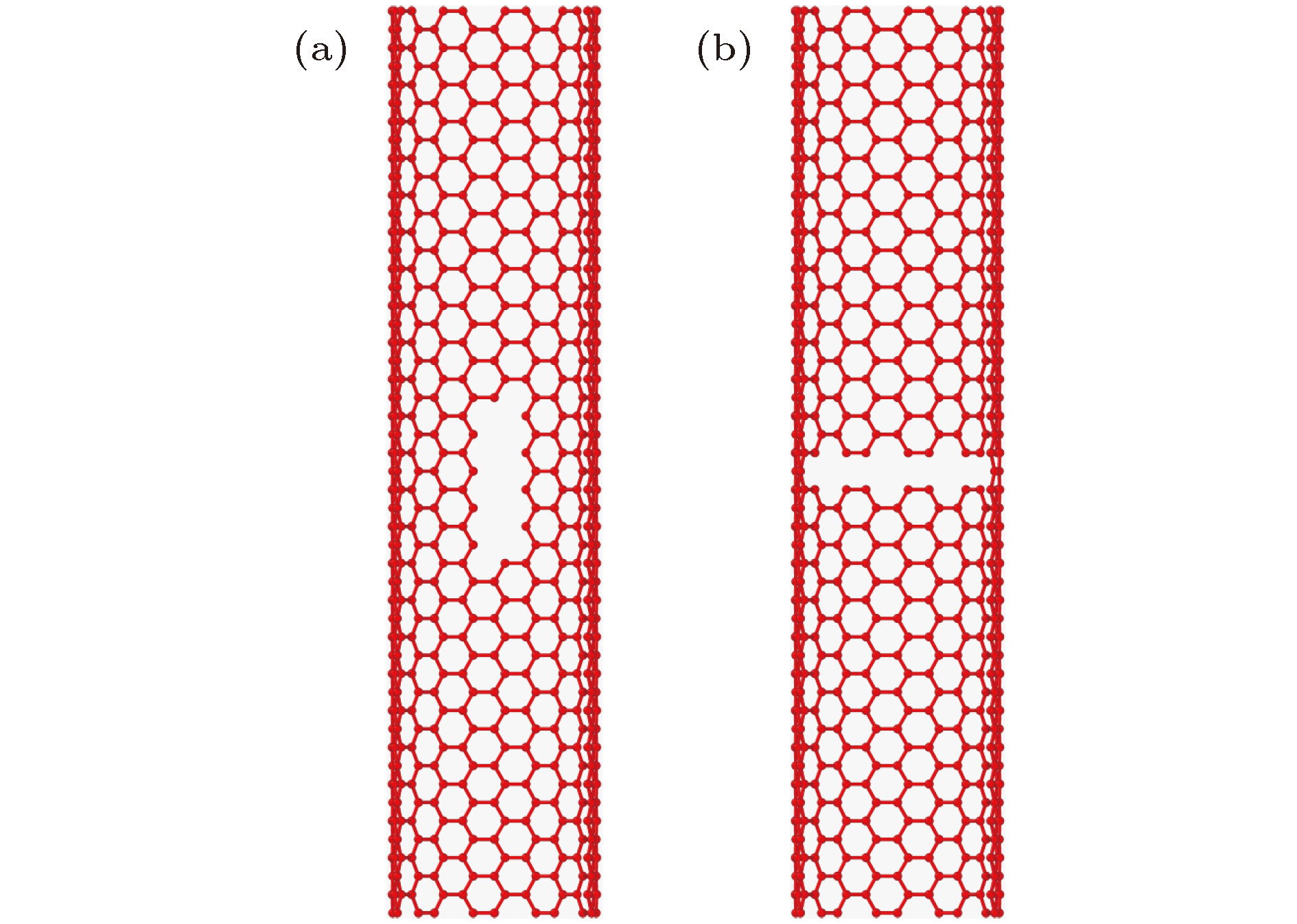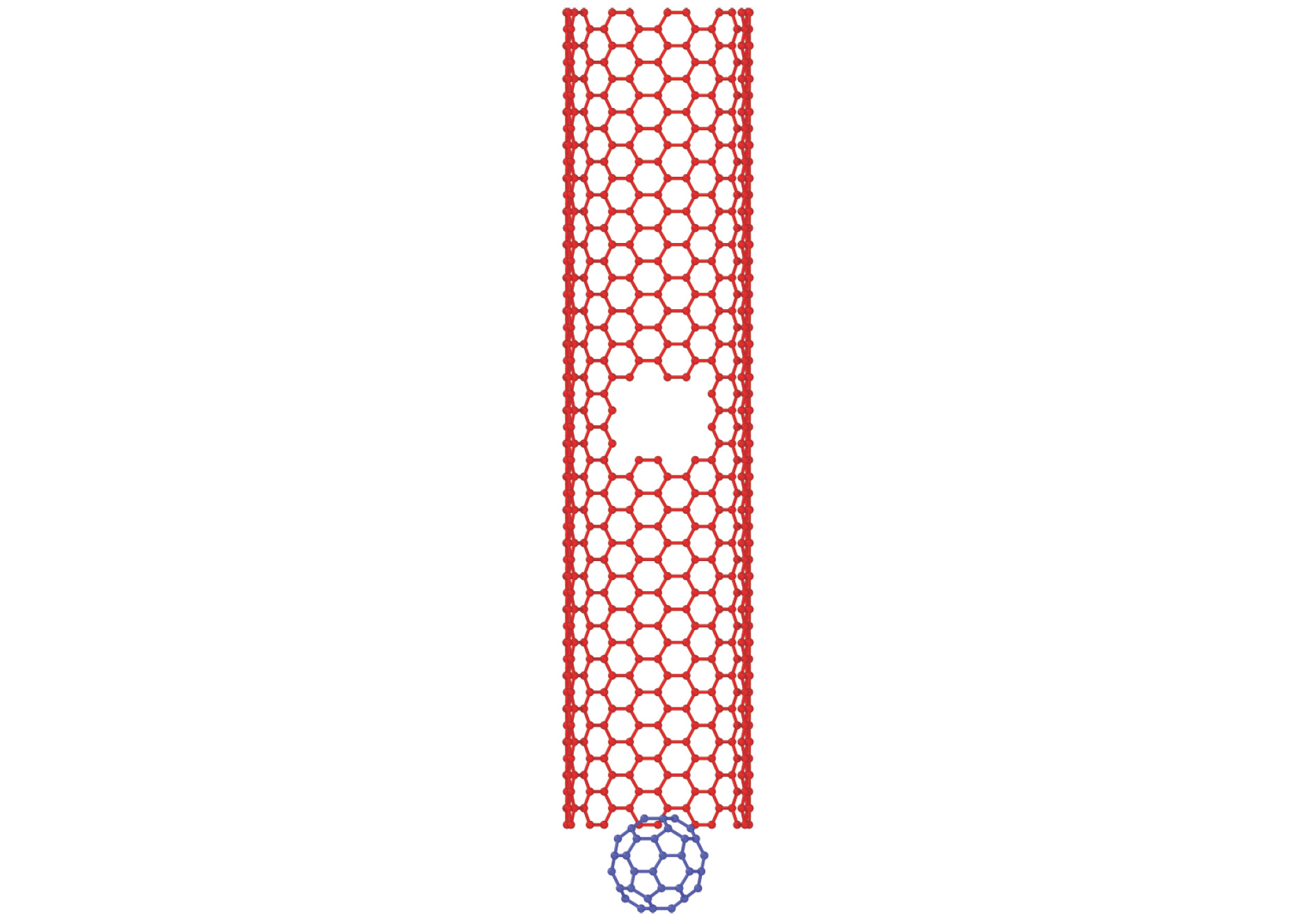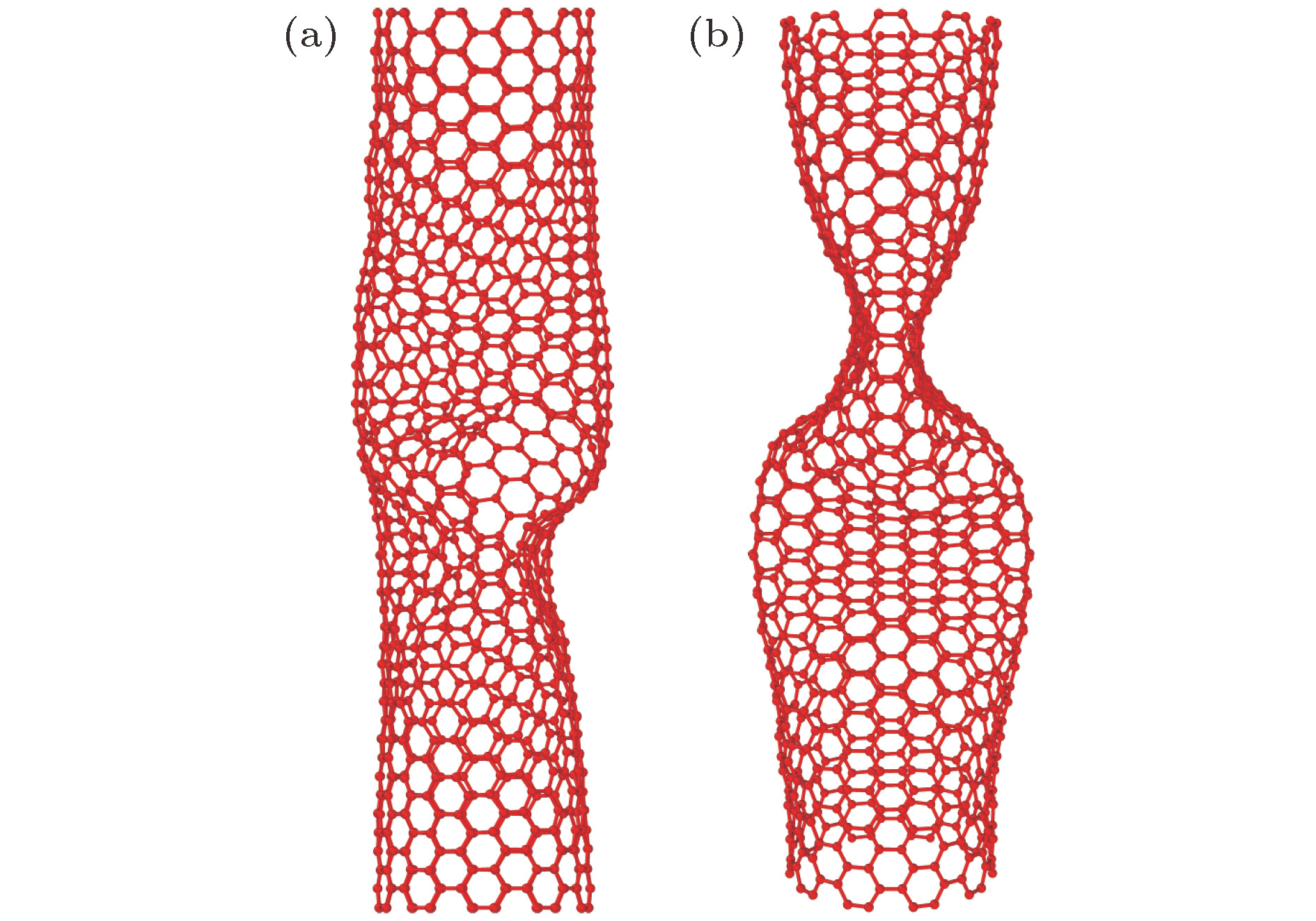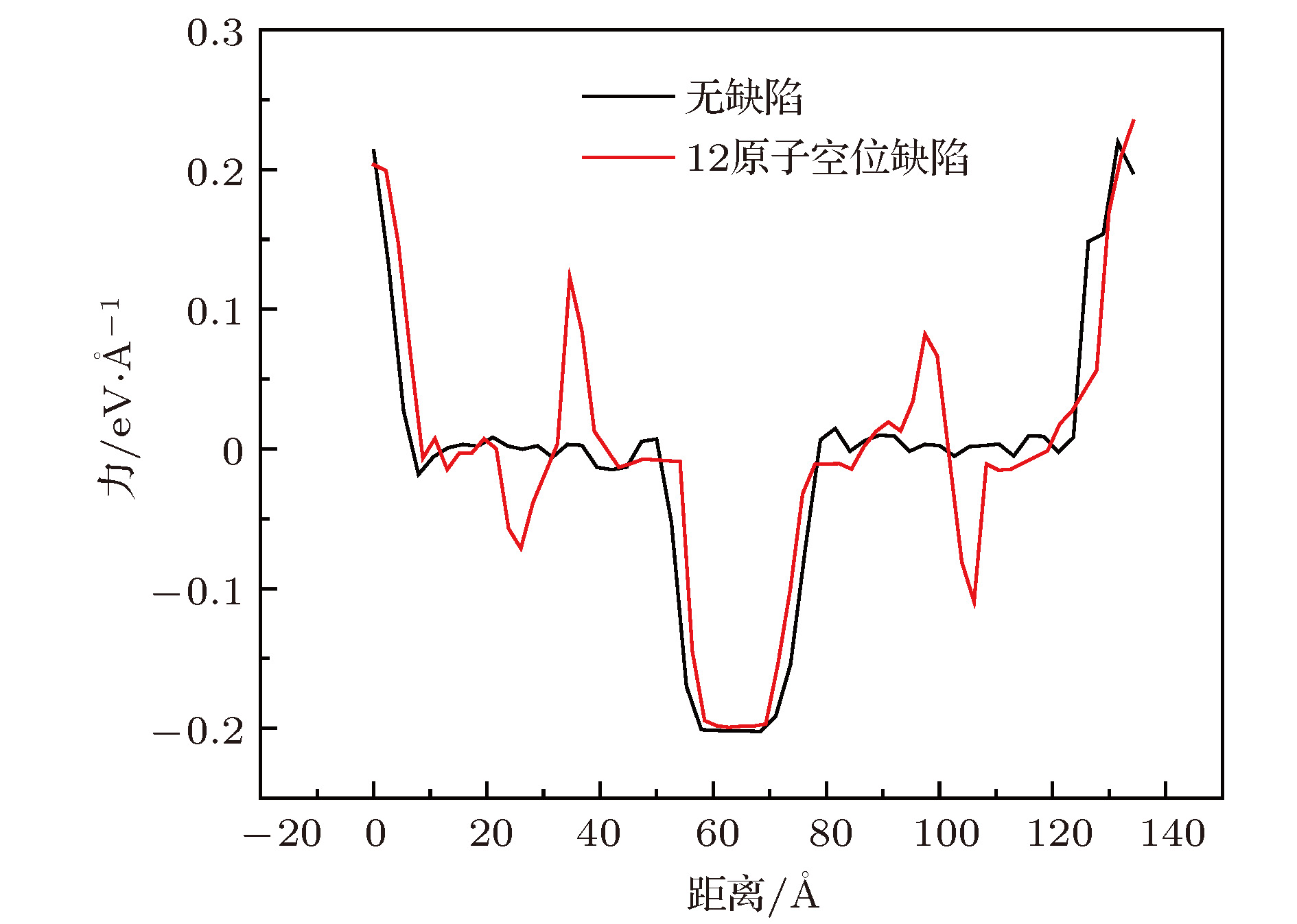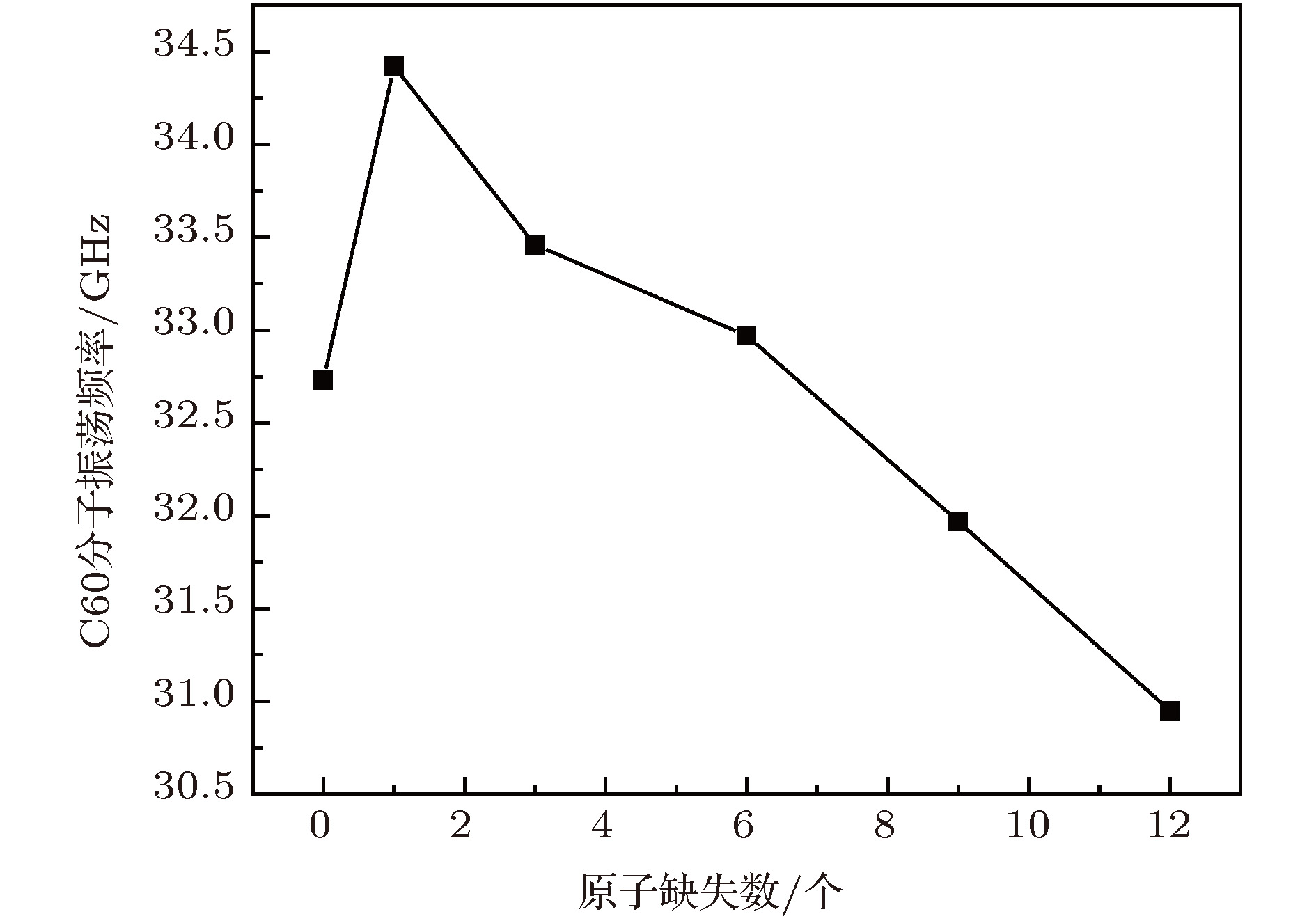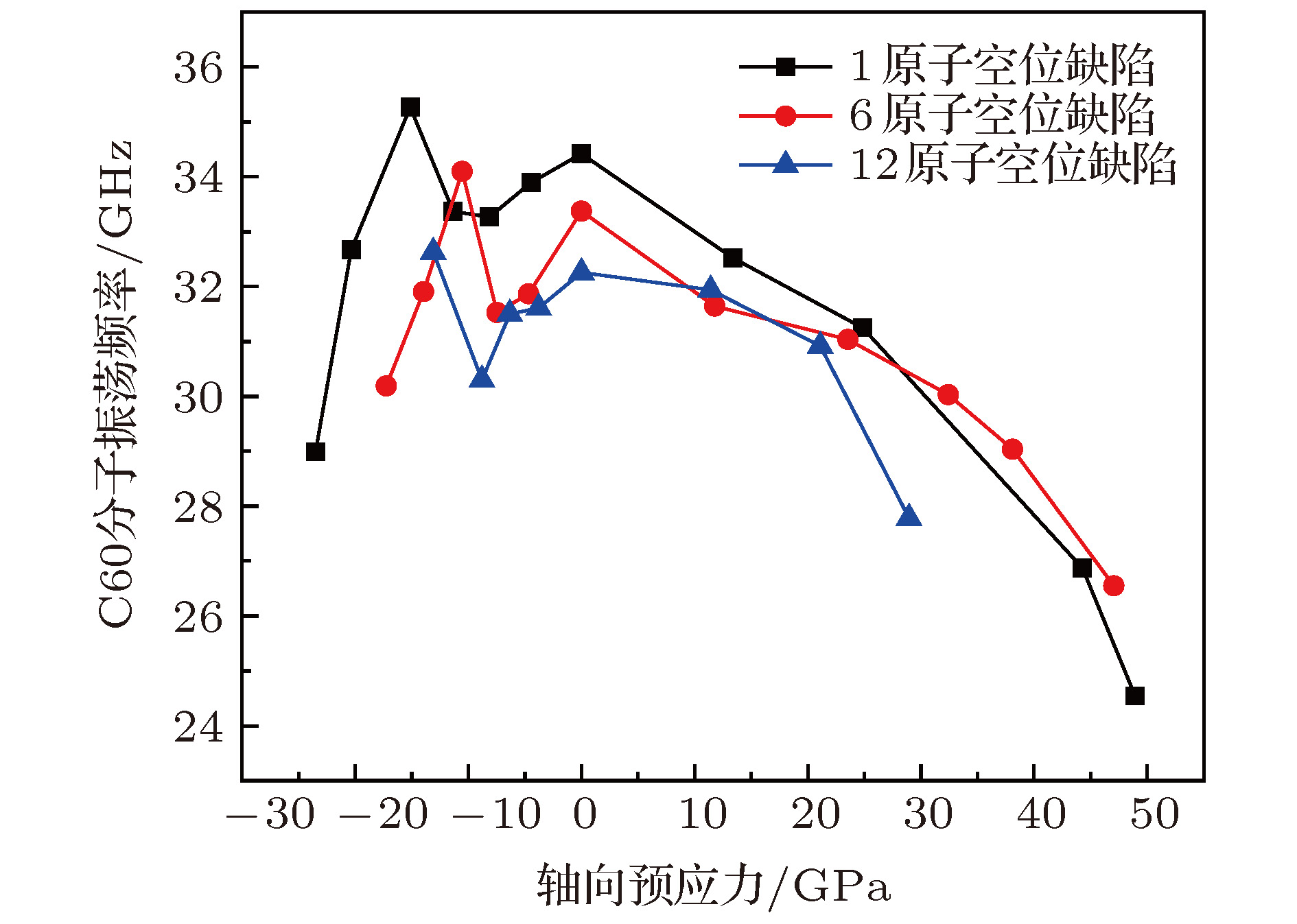-
采用分子动力学方法, 对含双空位及多空位缺陷碳纳米管进行静动力特性模拟研究. 首先讨论了双原子空位缺陷以及多原子空位缺陷对碳纳米管的准静态力学性质的影响, 然后讨论了缺陷以及轴向预应力对碳纳米豆荚内C60分子振荡动力学的影响. 研究表明, 相对于无缺陷碳纳米管, 含不同类型双原子空位缺陷碳纳米管的极限应力、极限应变和弹性模量都大幅下降; 当碳纳米管缺陷原子较多, 缺陷连接在一起形成类似裂纹之后, 使得碳纳米管轴向抗压性能大幅降低, 裂纹沿周向发展相比于裂纹沿轴向发展, 其抗压能力下降得更多, 这类似于含裂纹的壳体模型结构抗压性能的下降; 缺陷碳纳米豆荚中C60分子的振荡频率受到缺失的碳原子数的影响, 单原子空位缺陷使得C60分子的振荡频率增大, 但随着空位数的增多, C60分子的振荡频率会逐渐减小; 当缺陷碳纳米豆荚存在轴向预应力时, C60分子的振荡不仅受到缺陷影响, 同时还受到轴向预应力的影响, 这使得C60分子振荡变得更为复杂.The static and dynamic mechanical characteristics of carbon nanotubes with double and multiple vacancy defects are simulated by the molecular dynamics method. Firstly, the effects of diatomic and polyatomic vacancy defects on the quasi-static mechanical properties of carbon nanotubes are discussed. Then, the effects of defects and axial pre-stress on the dynamics of C60 molecular oscillation in carbon nano-peapods are discussed. The results show that the ultimate stress, ultimate strain and elastic modulus of carbon nanotube containing different types of diatomic vacancies are significantly reduced as compared with those of non-defective carbon nanotubes. When the carbon nanotubes have many defective atoms and the defects are connected together to form a crack, the axial compressive properties of the carbon nanotubes are greatly reduced. Compared with the circumferential development of cracks, the cracks along the axis greatly reduce the compressive capacity of carbon nanotubes, which is similar to that of shell models with cracks. The oscillation frequency of C60 molecular in defective carbon nano-peapods is affected by the number of missing atoms. The single vacancy defect increases the oscillation frequency of C60 molecule, while with the further increase of vacancy number, the oscillation frequency of C60 molecule decreases gradually. When the defective carbon nano-peapod has axial tensile or compressive pre-stress, the oscillation of the C60 molecule is affected not only by the defects, but also by the axial pre-stress, which makes the oscillation of C60 molecule more complicated.
-
Keywords:
- carbon nanotubes /
- carbon nano-peapods /
- defects /
- static and dynamic mechanical characteristics
[1] Iijima S 1991 Nature 354 56
 Google Scholar
Google Scholar
[2] Krishnan A, Dujardin E, Ebbesen T W 1998 Phys. Rev. B 58 14013
 Google Scholar
Google Scholar
[3] Berber S, Kwon Y K, Tomanek D 2000 Phys. Rev. Lett. 84 4613
 Google Scholar
Google Scholar
[4] Rinzler A G, Hafner J H, Nikolaev P, Lou L, Kim S G, Tomanek D, Nordlander P, Colbert D T, Smalley R E 1995 Science 269 1550
 Google Scholar
Google Scholar
[5] Popov V N 2004 Mater. Sci. Eng. R 43 61
 Google Scholar
Google Scholar
[6] Harris P J F, Hernandez E, Yakobson B I 2004 Am. J. Phys. 72 413
 Google Scholar
Google Scholar
[7] Stone A J, Wales D J 1986 Chem. Phys. Lett. 128 501
 Google Scholar
Google Scholar
[8] Nardelli M B, Yakobson B I, Bernholc J 1998 Phys. Rev. B 57 4277
 Google Scholar
Google Scholar
[9] Hirai Y, Nishimaki S, Mori H, Kimoto Y, Akita S, Nakayama Y, Tanaka Y 2003 Jpn. J. Appl. Phys. 42 4120
 Google Scholar
Google Scholar
[10] 辛浩, 韩强, 姚小虎 2008 物理学报 57 4391
 Google Scholar
Google Scholar
Xin H, Han Q, Yao X H 2008 Acta Phys. Sin. 57 4391
 Google Scholar
Google Scholar
[11] 袁剑辉, 程玉民, 张振华 2009 物理学报 58 2578
 Google Scholar
Google Scholar
Yuan J H, Cheng Y M, Zhang Z H 2009 Acta Phys. Sin. 58 2578
 Google Scholar
Google Scholar
[12] Zhang Y Y, Xiang Y, Wang C M 2009 J. Appl. Phys. 106 113503
 Google Scholar
Google Scholar
[13] Kulathunga D D T K, Ang K K, Reddy J N 2010 J. Phys.: Condens. Matter 22 345301
 Google Scholar
Google Scholar
[14] 王锋, 曾祥华, 徐秀莲 2002 物理学报 51 1778
 Google Scholar
Google Scholar
Wang F, Zeng X H, Xu X L 2002 Acta Phys. Sin. 51 1778
 Google Scholar
Google Scholar
[15] Liu P, Zhang Y W, Lu C 2005 J. Appl. Phys. 97 094313
 Google Scholar
Google Scholar
[16] Song H Y, Zha X W 2009 Phys. Lett. A 373 1058
 Google Scholar
Google Scholar
[17] 崔柳, 冯妍卉, 檀鹏, 张欣欣 2015 科学通报 60 1414
Cui L, Feng Y H, Tan P, Zhang X X 2015 Chin. Sci. Bull. 60 1414
[18] 方炜, 王磊 2018 材料导报 32 164
Fang W, Wang L 2018 Mater. Rev. 32 164
[19] Plimpton S 1995 J. Comput. Phys. 117 1
 Google Scholar
Google Scholar
[20] Brenner D W, Shenderova O A, Harrison J A, Stuart S J, Ni B, Sinnott S 2002 J. Phys.: Condens. Matter 14 783
 Google Scholar
Google Scholar
[21] Stuart S J, Tutein A B, Harrison J A 2000 J. Chem. Phys. 112 6472
 Google Scholar
Google Scholar
[22] Lennard-Jones J E, Dent B M 1926 Proc. R. Soc. A 112 230
 Google Scholar
Google Scholar
[23] Girifalco L A, Hodak M, Lee R S 2000 Phys. Rev. B 62 13104
 Google Scholar
Google Scholar
[24] Rafizadeh H A 1974 Physica 74 135
 Google Scholar
Google Scholar
[25] Cox B J, Thamwattana N, Hill J M 2007 Proc. R. Soc. A 463 461
 Google Scholar
Google Scholar
[26] Cox B J, Thamwattana N, Hill J M 2007 Proc. R. Soc. A 463 477
 Google Scholar
Google Scholar
-
图 6 含多原子空位缺陷碳纳米管在轴向荷载作用下屈曲失稳构型 (a) 沿轴向分布的含多原子空位缺陷管; (b) 沿周向分布的含多原子空位缺陷管
Fig. 6. Buckling instability configuration of carbon nanotubes with polyatomic vacancy defects under axial loading: (a) Carbon nanotubes with polyatomic vacancy defects distributed along the axial direction; (b) carbon nanotubes with polyatomic vacancy defects distributed along the circumferential direction.
表 1 含双原子空位缺陷碳纳米管
Table 1. Carbon nanotubes containing diatomic vacancy defects.
编号 缺陷类型 间隔碳原子数 1 缺失1, 2位置原子 0 2 缺失1, 3位置原子 1 3 缺失1, 4位置原子 2 4 缺失1, 5位置原子 1 5 缺失1, 6 位置原子 0 6 缺失3, 6位置原子 2 表 2 轴压下双原子空位缺陷对碳纳米管力学性能影响
Table 2. Effect of diatomic vacancy defects on mechanical properties of carbon nanotubes under axial compression.
编号 极限应力/GPa 极限应变/% 弹性模量/GPa 1 27.96 3.76 743.6 2 28.26 4.00 706.5 3 28.28 4.00 707.0 4 29.06 4.24 685.4 5 31.21 4.20 743.1 6 30.34 4.30 705.6 7 40.86 4.85 842.5 -
[1] Iijima S 1991 Nature 354 56
 Google Scholar
Google Scholar
[2] Krishnan A, Dujardin E, Ebbesen T W 1998 Phys. Rev. B 58 14013
 Google Scholar
Google Scholar
[3] Berber S, Kwon Y K, Tomanek D 2000 Phys. Rev. Lett. 84 4613
 Google Scholar
Google Scholar
[4] Rinzler A G, Hafner J H, Nikolaev P, Lou L, Kim S G, Tomanek D, Nordlander P, Colbert D T, Smalley R E 1995 Science 269 1550
 Google Scholar
Google Scholar
[5] Popov V N 2004 Mater. Sci. Eng. R 43 61
 Google Scholar
Google Scholar
[6] Harris P J F, Hernandez E, Yakobson B I 2004 Am. J. Phys. 72 413
 Google Scholar
Google Scholar
[7] Stone A J, Wales D J 1986 Chem. Phys. Lett. 128 501
 Google Scholar
Google Scholar
[8] Nardelli M B, Yakobson B I, Bernholc J 1998 Phys. Rev. B 57 4277
 Google Scholar
Google Scholar
[9] Hirai Y, Nishimaki S, Mori H, Kimoto Y, Akita S, Nakayama Y, Tanaka Y 2003 Jpn. J. Appl. Phys. 42 4120
 Google Scholar
Google Scholar
[10] 辛浩, 韩强, 姚小虎 2008 物理学报 57 4391
 Google Scholar
Google Scholar
Xin H, Han Q, Yao X H 2008 Acta Phys. Sin. 57 4391
 Google Scholar
Google Scholar
[11] 袁剑辉, 程玉民, 张振华 2009 物理学报 58 2578
 Google Scholar
Google Scholar
Yuan J H, Cheng Y M, Zhang Z H 2009 Acta Phys. Sin. 58 2578
 Google Scholar
Google Scholar
[12] Zhang Y Y, Xiang Y, Wang C M 2009 J. Appl. Phys. 106 113503
 Google Scholar
Google Scholar
[13] Kulathunga D D T K, Ang K K, Reddy J N 2010 J. Phys.: Condens. Matter 22 345301
 Google Scholar
Google Scholar
[14] 王锋, 曾祥华, 徐秀莲 2002 物理学报 51 1778
 Google Scholar
Google Scholar
Wang F, Zeng X H, Xu X L 2002 Acta Phys. Sin. 51 1778
 Google Scholar
Google Scholar
[15] Liu P, Zhang Y W, Lu C 2005 J. Appl. Phys. 97 094313
 Google Scholar
Google Scholar
[16] Song H Y, Zha X W 2009 Phys. Lett. A 373 1058
 Google Scholar
Google Scholar
[17] 崔柳, 冯妍卉, 檀鹏, 张欣欣 2015 科学通报 60 1414
Cui L, Feng Y H, Tan P, Zhang X X 2015 Chin. Sci. Bull. 60 1414
[18] 方炜, 王磊 2018 材料导报 32 164
Fang W, Wang L 2018 Mater. Rev. 32 164
[19] Plimpton S 1995 J. Comput. Phys. 117 1
 Google Scholar
Google Scholar
[20] Brenner D W, Shenderova O A, Harrison J A, Stuart S J, Ni B, Sinnott S 2002 J. Phys.: Condens. Matter 14 783
 Google Scholar
Google Scholar
[21] Stuart S J, Tutein A B, Harrison J A 2000 J. Chem. Phys. 112 6472
 Google Scholar
Google Scholar
[22] Lennard-Jones J E, Dent B M 1926 Proc. R. Soc. A 112 230
 Google Scholar
Google Scholar
[23] Girifalco L A, Hodak M, Lee R S 2000 Phys. Rev. B 62 13104
 Google Scholar
Google Scholar
[24] Rafizadeh H A 1974 Physica 74 135
 Google Scholar
Google Scholar
[25] Cox B J, Thamwattana N, Hill J M 2007 Proc. R. Soc. A 463 461
 Google Scholar
Google Scholar
[26] Cox B J, Thamwattana N, Hill J M 2007 Proc. R. Soc. A 463 477
 Google Scholar
Google Scholar
计量
- 文章访问数: 11997
- PDF下载量: 80
- 被引次数: 0














 下载:
下载:

